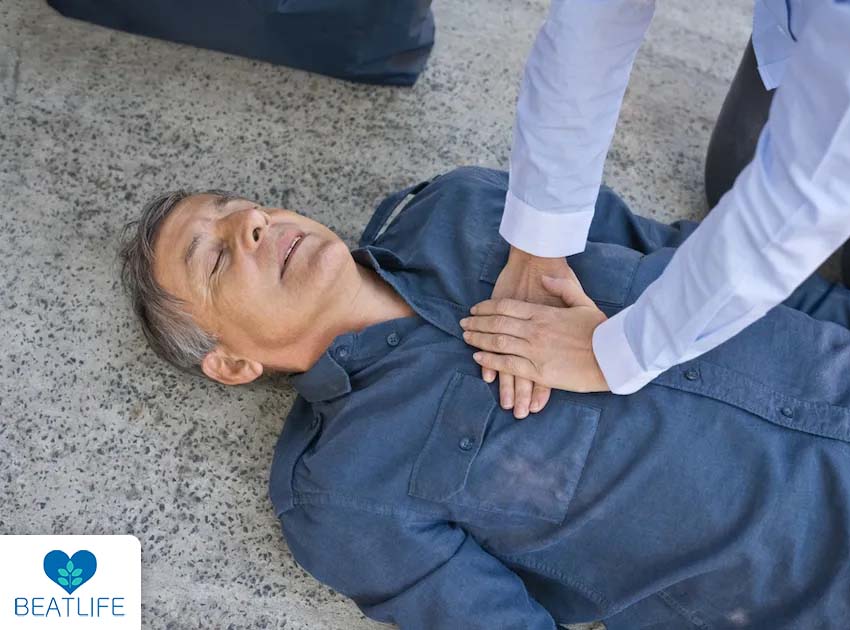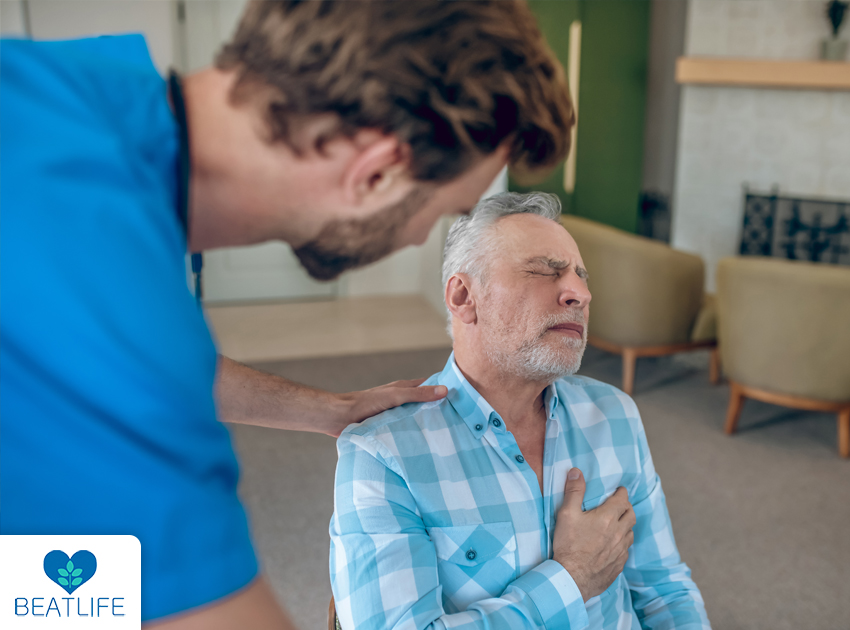A heart attack, also known as a myocardial infarction, is the result of a blockage of blood flow to a part of the heart. A part of the heart muscle that is impacted by limited blood flow is deprived of oxygen and starts to decease. Therefore, a heart attack needs immediate medical attention. Surviving a heart attack is a huge accomplishment; It also marks the start of a new chapter in the patient’s life.
In this blog post, we explore what happens after a heart attack, provide a guide to recovery and also introduce CPRMETER, a CPR feedback device made available by Beatlife, which can make people’s lives easier while managing their heart condition.
Contents
What to Expect Physically After a Heart Attack?
The body goes through a sequence of reactions right after a heart attack to recover after the damage and restore its normal function. These reactions include:
1. Inflammation:
In response to tissue damage, the immune system of the body releases chemicals and cells that cause inflammation. Debris and dead cells leave the damaged area as result of this inflammatory reaction.
2. Scar formation:
Over time, scar tissue grows in place of the injured heart tissue. Scar tissue aids in preserving the structural integrity of the heart though it cannot contract like healthy heart muscle.
3. Collateral circulation:
In some cases, new blood vessels may grow around the blocked artery to give blood a different path. This procedure, known as collateral circulation, can lessen discomfort and enhance blood flow to the injured area.
4. Remodeling:
The heart may undergo changes in size and form following a heart attack. The heart goes through this remodeling process in an attempt to repair the damaged tissue. On the other hand, over remodeling may eventually result in heart failure.
5. Rehabilitation:
After a heart attack, recovery depends heavily on rehabilitation. Exercise training, lifestyle modifications, and education on controlling risk factors including diabetes, high blood pressure, and high cholesterol are all common components of cardiac rehabilitation programs.

What Medical Treatment Is Required After a Heart Attack?
After a heart attack, immediate medical attention is crucial to the patient’s survival and recovery. The first and most crucial step is to dial the local emergency number or ask for help from nearby medical professionals in order to request emergency medical treatment. It’s crucial to keep the patient relaxed and comfortable while you wait for the first responders to arrive.
The medical professionals will assess the patient’s condition and administer any necessary treatments as soon as they arrive. In order to stabilize the patient’s state and help with breathing, this may involve giving them oxygen. Aspirin or nitroglycerin are examples of emergency medications that may be given in certain situations to help with symptoms and stop further complications.
After arriving at the hospital, the patient will go through further evaluation, which could involve blood tests to monitor cardiac enzymes and an electrocardiogram (ECG) to evaluate the electrical activity of the heart. The results of these tests help in determining the degree of heart damage and identifying the best course of action.
What Is the Recovery Process for a Heart Attack?
After a heart attack, the recovery process is very important and it needs careful attention to medical recommendations. Improving general heart health and preventing further heart attacks are the main goals of the recovery process.
Patients are usually recommended to follow to a complete cardiac rehabilitation program after being released from the hospital. Exercise, education, and counseling are frequently combined in this program to assist patients in making the essential lifestyle modifications.
Exercise is an important part of the recovery process since it increases cardiovascular fitness and strengthens the heart. Under the supervision of medical professionals, patients are typically advised to begin with low-impact exercises like walking or cycling and progressively increase the intensity and duration of their workouts.

How to Improve Heart Health After a Heart Attack?
Making lifestyle adjustments after a heart attack is essential in reducing the risks of further health complications. Making these adjustments is crucial to enhancing general heart health and preventing further health issues:
- Following a heart-healthy diet with lots of fruits, vegetables, and whole grains
- Engaging in regular exercise as recommended by a professional
- Quitting smoking and avoiding secondhand smoke
- Managing stress through methods like meditating or counseling
- Monitoring and controlling blood pressure through medication and lifestyle modifications
- Managing and controlling cholesterol level through diet and medication
- Attending cardiac rehabilitation programs
- Limiting alcohol consumption
- Maintaining a healthy weight align with body’s demands
- Seeking regular medical follow-up and adhering to prescribed medications

What Is the Follow-up Treatment for a Heart Attack?
After a heart attack, it is essential to adhere to a thorough medication and care plan in order to facilitate recovery process and reduce the risk of further health problems.
The specific medications and the follow-up care after the heart attack may vary depending on the severity of the heart attack and each individual’s health conditions. Nonetheless, the following follow-up care are commonly advised:
1. Cardiac rehabilitation:
It is strongly advised that patients take part in a systematic cardiac rehabilitation program in order to help them restore strength, increase their cardiovascular fitness, and learn about heart-healthy lifestyle options.
2. Lifestyle modifications:
To improve heart health and reduce the risk of developing future heart issues, these modifications can include dietary adjustments, regular exercise, quitting smoking, and stress management.
3. Regular medical appointments:
Scheduling regular check-ups with a healthcare professional is crucial for monitoring heart function, making any medication adjustments, and addressing any symptoms or concerns.
4. Emotional support:
Patients should get emotional support and counseling as needed to treat their anxiety, despair, or other psychological repercussions because a heart attack can have a substantial emotional impact.
5. Long-Term Monitoring:
Long-term monitoring of cardiovascular health plays an important role to ensure overall health and prevent future heart problems. Periodically, additional testing, including stress tests or electrocardiograms (ECGs), could be advised to assess the progress.
CPRMETER is another tool used for monitoring heart function during and after a heart attack. During a heart attack, CPRMETER continuously monitor the patient’s heart rate, and provides real-time feedback on the effectiveness of CPR. CPRMETER can also be used to track the patient’s recovery progress by monitoring their heart function. This can help healthcare providers assess the effectiveness of recovery process and make decisions accordingly.
conclusion
In conclusion, the body goes through a number of changes after a heart attack in an effort to heal the damage and restore the normal function. Understanding these changes is crucial for preventing further cardiac events. People can enjoy their normal lives after having a heart attack if they receive the appropriate medical attention, have emotional support, and maintain a heart-healthy lifestyle. Remember that you are not alone; Seek out assistance and seize the chance to live a happy life.

